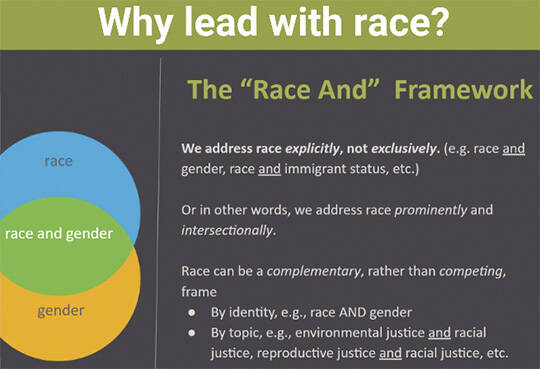All types of equity are important to Bainbridge Island leaders as they work on updating the Comprehensive and Winslow Subarea plans.
But BI’s first equity and inclusion manager wants the city to first focus on racial equity. She said other types of equity — income, age, gender, etc. — all apply to people of color also. “Racism is embedded” in the others,” Anshu Wahi said.
Wahi was talking to the Steering Committee for the Winslow and Comp plans. It is made up of three members from both the City Council and Planning Commission. Its mission is to ensure the public is involved in both plans, as each initially was dominated by consultants and city staff.
Wahi said in updating the plans the city needs to consciously set policies that “prevent discrimination.” She added that “all kinds of marginalization” have happened in the past, “some on purpose, some not.” She said when the city thinks about outreach it needs to specifically target people of color. Wahi mentioned, for example, that if BI wants to reach folks in the LGBTQ community for a meeting, “Everybody there is white,” unless people of color are specifically sought. “People of color don’t think they can make a difference, so we have that to overcome,” she said, adding, “We’re all part of the same social fabric.”
Wahi suggested that if city leaders are making decisions, and they don’t think they are “equity smart” they should include someone who is. She went as far to say when collecting information the city should think of paying people to participate and providing things like child care, transportation and interpreters. Wahi wanted to know what racial groups the city is hearing from already, and suggested people of color could lead focus groups. Many people of color cannot afford to live on BI, so they must be included if in the future the city wants more diversity.
Meanwhile, Autumn Salamack, the city’s climate change officer, talked to the committee about her focus area. When guiding policy in both the Comp and Winslow plans, the city needs to think about climate change issues such as: sea level rise, extreme temperatures and ocean acidification. Her efforts include outreach educating the public on those things, reducing greenhouse gas emissions and more. She said starting up cooling stations in BI during hot summer days is proof of climate change locally.
To emphasize the importance of reducing emissions, Salamack said the city needs to encourage things like carpooling and remote attendance when gathering public input. It also needs to consider the place and time of the event, along with low-carbon meal plans if food and beverages are served.
Following up on a topic from their previous meeting on place-making, Councilmember Leslie Schneider asked the group if they just want to encourage it or include it in actual plans.
The goal is to connect people to places they share. For example, she said nine months out of the year the Farmer’s Market is in Town Square on Saturday mornings. People consistently know something is happening.
Councilmember Jon Quitslund said the concept should always “factor into our thinking. Be part of our whole process. It’s a good time to introduce the concept.” It should be considered when coming up with rules for building heights, reducing footprints, bringing people to Winslow and even deciding on population growth on other parts of BI.
Planning Commissioner Ashley Mathews said the public spaces not only increase engagement through connections, but it’s her understanding it also improves public safety. She just wondered if the work could be done by city staff and consultants LMN Architects, rather than having to add someone else to increase the budget. As for the equity part, she said, “That’s pretty much a no-brainer.”
Planning Commissioner Sarah Blossom said she fully supports the concepts, not just in Winslow, but in other areas, too.
Schneider said such gathering places already exist on BI, but the city needs to develop them to be more vibrant. As an example, she said Sakai Park is an open space, and now that a large troll has been built there, “It’s a magnet” for drawing more people to the area. “What generates excitement?”
Quitslund said the whole thing is a long process. It will be organic as people start using spaces in between buildings, “making it more and more active.” It will take more people living close to the spaces.
Councilmember Kirsten Hytopoulos added the city needs to make a “commitment to explore this.”
Planning director Patty Charnas said she would talk to staff and the consultants to see what could be done and get back to the committee. “The muscle needs to be created and worked out.”



